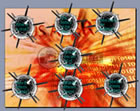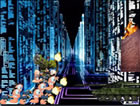Outcomes
The excellent standard of the student outcomes for the year are testament to the successful implementation of the four major areas of strategic focus set by the cluster group (see Case Study BP604) – students were learning a wide range of new ICT skills and knowledge within a technology framework, while having fun and being highly creative.
Term 1 CD Covers project
Ethan Luke Matthew Monica Sven
Click images for larger versions of the CD labels and their booklets.
Term 2 Powerpoint presentations project
Ashley (.ppt, 2.7Mb) Ethan (.ppt, 2.4Mb) Luke (.ppt, 2.8Mb)
Michael (.ppt, 4Mb) Monica (.ppt, 6.2Mb) Paul (.ppt, 3.7Mb)
Note that these large files are not designed for use as web-based media.
Term 3 Website project
Ashley's Website Michael's Website Monica's Website
Steve is pleased with the structure of the course and the learning progression it delivered. "As well as a progression in skills and tech practice, there's also progression in the ICT knowledge with typography and design skills introduced in the print project in term one then we go back and revisit design principles that are more relevant to a solution on screen as opposed to a solution in print...so there's a progression there. And again in term three we look at good design principles in terms of a website."
Steve believes the quality of the student outcomes in all four units reflects not only the emphasis placed of skill, tech practice, and knowledge development but also the time put into encouraging student creativity.
He says some of the students were very creative in the way they approached their work. As an example he cites a Paul's PowerPoint presentation Worms (above), which starts with an animation of a battle scene in which a group of worms take over control of the inside of a computer.
Malcolm Howard believes having students produce material for their own demographic helps foster this creativity. "What we've been pushing is that they're producing material for a teenage target audience, and with that specific focus they've been doing way more creative things this year."
And so do the students. "I've enjoyed thinking of creative ideas... putting my mind to it and thinking what would attract the attention of the stakeholders," says Monica, whose visual diary is featured on the right menu.
One of the most noticeable outcomes of the course design, Steve says, was the obvious enjoyment and engagement of students (of all abilities) throughout the year. "I could see that the students enjoyed the course a lot more. They liked the variety in the project work and the higher creative element in it."
The manner in which students responded to working in groups in their final project delighted both Steve and Malcolm and encouraged them to consider embedding this unit into the programme. In term four, when students worked in groups it was clear the students were reinforcing earlier learning by teaching each other skills that may have slipped-by them earlier.
Group work was popular with the students. Student feedback included comments such as: "I like the new idea of working in teams..."; "Working in a team is much better because you can think of ideas together and its more interesting and fun..."; and "It's not so much like hard work because when you're working as an individual it takes a lot of time, whereas if everyone is doing a bit then its all much faster...."
Steve suggests the structured approach to the teaching of technological practice through a focus on specific components of practice within each unit gave students a familiarity with the process. This will ease the transition from Year 10 ICT into the Year 11 NCEA ICT course, he says, and he is confident the course provided a sound base for the students to build on as they move into the range of senior ICT programmes the school offers.
The success of the course, Steve says, can be judged by the number of students who opted to carry on with ICT into the senior school and the number of students opting for Year 10 ICT. "The students this year have been very highly motivated and we can see this in the high numbers coming through into Year 11 in 2007 and the quality of students who have opted in."













